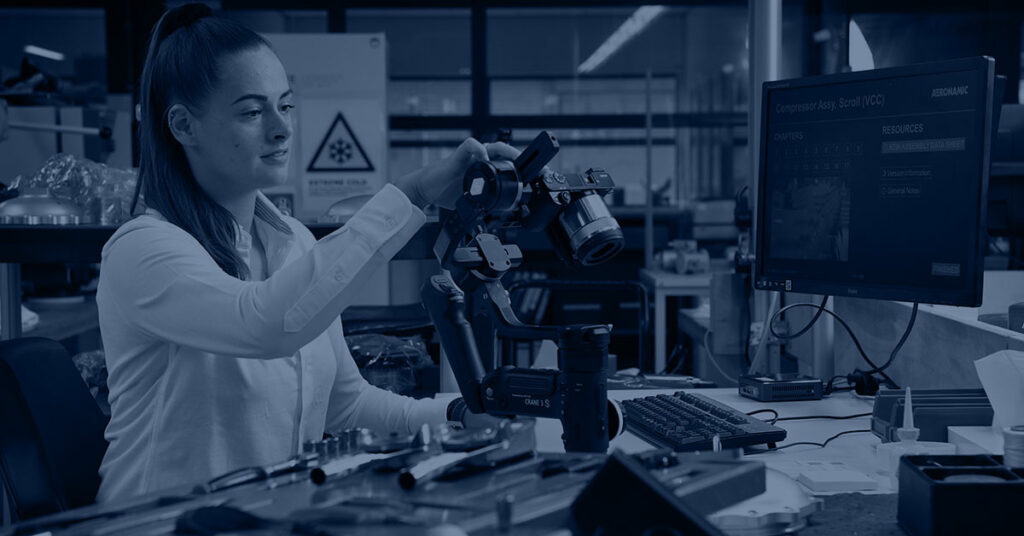THE HUMAN FACTOR IN BUSINESS OPTIMIZATION
Madelein van der Jeugd - Master's Student Public Administration

Madelein had a six-month internship at Aeronamic while she was studying Industrial Engineering and Management. Then she studied for a master’s degree on Public Administration … all while pursuing a promising career with us. In fact, her track record shows that she does what we at Aeronamic already do: push limits. But it’s the thinking behind her choices which makes it interesting to dive a little deeper into her field of expertise. And to see how it links to the direction our industry is heading in.
“I’ve always had a thing for technology. I would consider myself a technology ‘fan’, but I’m not a technician nor a mechanical engineer. My curiosity is in the area where technology and people meet and that interest is constantly being refueled. While Industrial Engineering is very straight forward, Public Administration has a tendency to be fuzzier, focusing more on the people side of things. Both fields of study are useful and it helps to understand their thought processes because you can then reason things out from both perspectives. This would apply, for instance, to a partnership between a private company and a government – which, of course, is the case with the close partnership between us at Aeronamic and the Department of Defense.”
Assembly of the scroll compressor
A great example of business optimization is in the assembly of our scroll compressor. Our assembly work has to take into account a variety of factors: handling time, accuracy levels, and so on. Handling time by itself has a lot of layers to consider: How to determine it beforehand and whether to record it during assembly or afterwards. However, during the whole process, there is always the risk of (unintentional) human error.
“My internship began with an assignment to map out our assembly process from the perspective of handling time. To determine the true handling time, one needs to capture and measure it in real time. When we started, we had the opportunity to apply the Lean Six Sigma method – a method taught at university but applied by Aeronamic as well. Whilst tracking Lean Six Sigma’s ‘8 possible wastes’, we made video recordings during the whole assembly process. Not only could we address the wastes we discovered with improvements, but we ended up using these videos to completely revamp our work instruction manuals. Instead of reading a regular printed manual, you can now use a complete interface which literally instructs you by showing and telling, pushing the idea of a work instruction manual to a level not seen before. And the output is amazing! (Which is why we did it, of course!) And a happy extra in these times of social distancing is that we can now explain our processes to our system integrators without distance being an issue. Meanwhile, we continue optimizing our work instructions as we go. We at Aeronamic are never done optimizing.”

What makes business optimization successful?
“You can research and optimize systems, processes or work instructions all you want, but if the people involved don’t pick up on it, there will be no progress. Not even an inch. This emphasizes the importance of creating a safe, worry-free work environment. There can be no implementation without acceptance. The human factor cannot be overlooked. My internship assignment was a great example of how suggested improvements can only be made by working together with colleagues. Without people, business optimization would never happen. People are what inspired me to hone my skills, first in Industrial Engineering and Management and now Public Administration. And so, on a personal level, it feels like a great achievement to be part of what we do here at Aeronamic, pushing these insights forward.”
The future of business optimization
“When it comes to business optimization, the talk is usually about working harder, better, stronger, faster … and companies and people usually go along with all this. But that’s not our approach. We believe business optimization should be about working smarter not harder; achieving the same goal more efficiently, with the same amount of input or less. If we’re somehow able to crystalize this and transfer it to the people in play, we would have all the right cards in our hand for achieving true progress. It would result in more meaningful work for more people. I love working with people because I believe in their uncharted potential. There’s a realm of possibilities waiting to be discovered. If you can see people for who they are and what they are capable of, that potential will benefit not only the other people involved but will also reflect your company’s strengths. The people factor will be a crucial factor for years to come, no matter how much we improve and progress. When it comes to the input for machines and automation, people always play a key role and—even more crucial—no machine can anticipate things the way our people can. We need to continue investing in people. In fact, let’s all keep an eye on what makes business optimization successful: the people factor. And let’s unchain its potential!”
How do you maintain the human factor in the process of optimization?